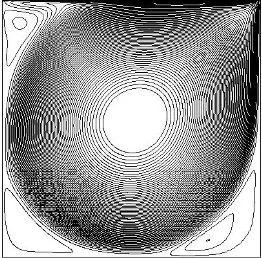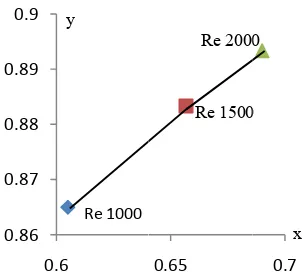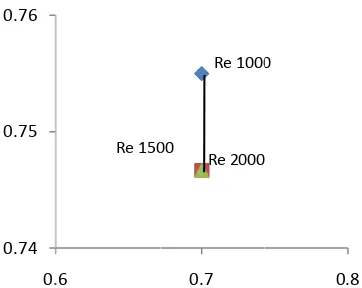Abstract—In this paper, fluid flow patterns of steady incompressible flow inside shear driven cavity are studied. The numerical simulations are conducted by using lattice Boltzmann method (LBM) for different Reynolds numbers. In order to simulate the flow, derivation of macroscopic hydrodynamics equations from the continuous Boltzmann equation need to be performed. Then, the numerical results of shear-driven flow inside square and triangular cavity are compared with results found in literature review. Present study found that flow patterns are affected by the geometry of the cavity and the Reynolds numbers used.
Keywords—Lattice Boltzmann method, shear driven cavity, square cavity, triangular cavity.
I. INTRODUCTION
OMPUTATIONAL Fluid Dynamics (CFD) has been extensively used for the analysis of system pertaining to engineering field like fluid flows, heat transfer, chemical reaction, evaporation, condensation [1].
Over the years, fluid flow behaviors inside lid driven cavities have drawn many interested researchers and scientists. Applications of lid driven cavities are in material processing, dynamics of lakes, metal casting, galvanizing and etc [2]. Numerous studies have been carried out on flow patterns inside a cavity. Excellent reviews on lid driven square cavity were done in [3]-[5]. On the other hand, the numerical simulation of driven triangular cavity flow had been conducted in [6]-[8]. These researchers used the conventional CFD method which is by solving the 2-D Navier Stokes equation.
In recent years, there has been a rapid progress in developing the lattice Boltzmann method (LBM) as an efficient alternative way to the conventional CFD methods.
A. M. Fudhail is with Faculty of Mechanical Engineering, Universiti Teknikal Malaysia Melaka, 76109 Melaka, Malaysia (phone: +606-3316575; fax: +606-3316511; e-mail: [email protected])
N. A. C. Azwadi is with Universiti Teknologi Malaysia, . He is with the Faculty of Mechanical Engineering, Universiti Teknologi Malaysia, 83100 Johor.Malaysia (e-mail: [email protected]).
M. Z. M. Rody is with Faculty of Mechanical Engineering, Universiti Teknikal Malaysia Melaka, 76100 Melaka, Malaysia (e-mail: [email protected])
H. M. Zahir is with Faculty of Mechanical Engineering, Universiti Teknikal Malaysia Melaka, 76100 Melaka, Malaysia (e-mail: [email protected])
M. T. Musthafah is with Faculty of Mechanical Engineering, Universiti Teknikal Malaysia Melaka, 76100 Melaka, Malaysia (e-mail: [email protected]).
The main advantage of LBM is its flexibility in terms of programming and better accuracy in dealing with complicated boundary of geometries [9]. In addition to that, the LBM is also better than the classical CFD in the range of small to moderate Reynolds numbers if dealing with flows in complex geometries [10].
II. LATTICE BOLTZMANN SCHEME
The basic idea of Boltzmann work is that a gas is composed of interacting particles that can be explained by classical mechanics [11]. The mechanics can be very simple where it contains streaming in space and billiard-like collisions interactions [11]. In addition to that, since there are many particles involves, a statistical treatment is needed and is more suitable.
The statistical treatment of a system can be represented in terms of distribution function. This distribution functions , , is the number of particles which its positions and velocities are and at time respectively. Each particle would move from to ∆ if there is no collision occurs. Each particle velocity would change from ∆ in which is the acceleration due to external forces on a particle at with a velocity of . No collision means there is conservation of molecules which can be represented in equations of [12] :
∆ , ∆ , ∆ , , 0 (1)
However, if there is collision occurs, the equation represent this particular case is as follow:
∆ , ∆ , ∆ , , Ω (2)
where , , is the single particle distribution function with descrete velocity of c and Ω is the Boltzmann collision operator. It is from this equation that Bhatnagar-Gross-Krook (BGK) collision model was developed and further derived to become BGK - LBM equation.
In general, the descretised version of BGK LBM equation can be written as follow:
(
)
( )
⎟⎟⎠ ⎞ ⎜
⎜ ⎝ ⎛ − Δ − = −
Δ + Δ +
f eq i i i
i i
f f t t f t t t f
τ
,
, x
c
x (3)
Numerical Simulations of Shear Driven Square
and Triangular Cavity by Using Lattice
Boltzmann Scheme
A.
M. Fudhail, N. A. C. Sidik, M. Z. M. Rody, H. M. Zahir, and M.T. Musthafah
Where is equilibrium distribution function and is the time relaxation.
The Lattice Boltzmann model with BGK collision operator or BGK model in short, is the classical LB fluid model. This model is most often used to solve the incompressible Navier-Stokes equations.
III. NUMERICAL PROCEDURE
In this study, apart from square cavity geometry, two different types of triangle geometries were also considered. The first type is an isosceles triangle with the 90° being at the top right corner. On the other hand, the second type is an isosceles triangle with 90° being at the top left corner. The value of Reynolds (Re) numbers is varied for each case of cavity geometry.
The simulations of flow of lid driven square cavity are conducted for different range of Reynolds (Re) numbers. The top wall velocity, U was maintained at 0.1 lattice unit per second (lu/s) while the velocity of other three walls which is right, left and below was set to 0 lu/s. The fluid temperature is maintained to be constant (isothermal). The Re numbers are varied from 7500, 9000, and 12500.
On the other hand, the simulation of flow in shear driven triangular cavity is performed for Re number of 1000, 1500, and 2000. The rest of the parameters are equal to the square cavity.
IV. SIMULATION RESULTS A. Shear Driven Square Cavity
The graph of velocity profile at mid height of each x and y axis were plotted for Reynolds number of 7500. The graph obtained in Fig. 1 for Re number of 7500 were compared with the numerical results in [3]. Good agreements between LBM and in [3] have been found for Re number equal to 7500.
Fig. 1 Velocity profile at mid-height (x-velocity,Ux & y- velocity,Uy) of cavity for Re number 7500. Line-LBM and symbol-
Ghia et al[3]
Apart from the numerical results, the streamline patterns were also shown for each Re number. These patterns are plotted when steady state solution is achieved. The streamline patterns are shown as in Fig. 2 to Fig 4. The figures depict that there is addition in terms of the number of secondary vortex when the Re number is increased. As shown in the Fig. 4, the number of secondary vortex is increase from 3 to 4 when the Reynolds number is increased from 9000 to 12500.
Fig. 2 Streamline patterns for Re number of 7500
Fig. 3 Streamline patterns for Re number of 9000
Fig. 4 Streamline patterns for Re number of 12500
The location of the primary vortex is also plotted on a graph as shown in Fig. 5. From the graph, it shows that the primary vortex moves downstream as Re number increases.
‐1
‐0.5 0 0.5 1
Fig. 5 Grap
B. Shear D Fig. 6 (a) triangle with shown, ther streamline c vortices is in we can see
ph of the locatio
Driven Triang to (c) shows t h 90° at the t re are two si contours. The ncreased when
on of primary vo numbers
gular Cavity the streamline top right corn gnificant feat first feature n the Re numb
ortex for respec
e patterns for ner. From th tures revealed
is that the nu bers are increa of vortex is i
On the other centre of the p Reynolds num plotting the loc corresponding 7.
Fig. 7 Graph of
On the othe contours for t corner. From mber is increa
cation of the p Reynolds num
f the location of with 90° at th
er hand, Fig. the isosceles the figures, it am to the rig his is contrar gle with 90° a 0.6
Re 1000
y
Re 2000
erns for isoscele p right corner
cond significa x moves upst ased. This ca primary vorte mber. The gra
f primary vortex he top right cor
8 (a) to (c) sh triangle with is noticed tha ght as Reyno ry to the re at the top right
0.65
Re 2000
Re 1500
es triangle with
ant feature is t tream to the r an be confirm ex on a graph
aph is shown
x for isosceles t rner.
hows the stre 90° at the t at the primary
Fig. 8 (a)-(c)
From thes increases wh the Re numb in the stream contour is isosceles tria number is si number incr proven in the
(a
(b
(c
Streamline patt the
se figures, it sh hen the Re nu ber is increase mline pattern. significantly angle with 90° imilar in each reases, the pri e graph in Fig
a) Re 10
b) Re 15
c) Re 20
terns for isoscel top left corner.
hows that the umber is highe ed to 1500, the
It is also notic y different fr ° at the top rig h cases. Apar imary vortex m g. 9.
000
500
00
les triangle w
number of vo er. For instan e third vortex ced that the st from the res ght corner alth rt from that, a moves downs
with 90° at
ortex also ce, when square and successfully. number of 75 with the refere Apart from affected by th driven cavity.
he primary vo he Reynolds n Last but no cavity are depe
The authors Multigrid M 48, 1982, p 4] E. Erturk., 2-D Stead Reynolds N Methods in 5] S. Albens dimensiona Physics., vo 6] E. Erturk a
f the location of with 90° at t
V. CO lity of LBM
triangular c Numerical r 00 for square ences. m that, the n
he increase o In addition to ortex in drive numbers. ent of Malay
REF
Azwadi and A. of Fluid Fl ed.
arif, “Laminar m vities with hot
Applied Therma .
K.N. Ghia and sible Flow usin Method”, Jour pp. 387-411.
T.C. Corke and dy Incompressi Numbers”, In n Fluids., vol. 4
soeder and H al lid-driven cav ol. 206, 2005, p and O. Gokcol cavity flow”, hysics, Vol.38,
.6
Re 150
f primary vortex the top left corn
ONCLUSION
to simulate f cavity has b
results that a e cavity are i number of se
of Reynolds o that, the loca en cavity flow streamline con eometry of the
OWLEDGMENT
to thank the , Universiti T ysia for suppo
FERENCES
M. Fudhail, “ low in a Sh
mixed convecti moving lid on al Engineering
d C.Y. Shin, “H ng the Navier-S rnal of Comput
d O. Gokcol, “N ible Driven C nternational Jo , The Europe 2007, pp. 97-1
0.7 Re 1000
00
Re 2000
x for isosceles t ner.
flow in shear been demon are obtained
in good agree econdary vor numbers for ation of the ce w is also affec ntours of flow e cavity itself.
Universiti Te Teknologi M orting this re
“Mesoscale Nu hear Driven C
ion in shallow i n top and coole g., vol. 27, 20
High Re Soluti Stokes Equation tational Physic
Numerical Solu Cavity Flow a ournal for Nu
7-774. nn, “Accurate urnal of Comput
[7] M. Li and T. Tang, “Steady Viscous Flow in a Triangular Cavity by Efficient Numerical Techniques”. Computers Mathematics Application, Vol. 31, No 10, 1996, pp.55-65. [8] C.J. Ribbens, L.T. Watson, and C.Y. Wang, “Steady Viscous
Flow in a Triangular Cavity”, Journal of Computational Physics, Vol. 112. 1992.
[9] G. Poutrelli, S. Ubertin and S. Succi, “The unstructured lattice Boltzmann Method for Non-Newtonian Fluid, vol. 06, 2009.
[10]O. Filippova and D. Hanel, “Grid Refinement for Lattice-BGK Models”, Journal of Computational Physics, vol.147, 1998, pp. 219-228.
[11]Sukop, M.C. and Thorne, D.T., Lattice Boltzmann Modeling: An introduction for geoscientists and engineers, Springer, New York, 2006.
[12]C.S. N. Azwadi, “The Development of New Thermal Lattice Boltzmann Models for the Simulation of Thermal Fluid Flow Problems. Doctor of Philosophy, Keio University, Japan. 2007. [13]C.S. N. Azwadi and T. Tanahashi, “Simplified Thermal Lattice Boltzmann in Incompressible Limit”, International Journal of Modern Physics, B 20, 2006, pp. 2437-2449.
[14]C. H. Bruneau, and M. Saad, “The 2D Lid Driven Cavity Problem Revisited ”, Computers and Fluids., vol. 35, 2006, pp 326-348.
Fudhail Abdul Munir received the Bachelor of Engineering (2006) in mechanical engineering from International Islamic University of Malaysia. He then obtained his Master degree in Mechanical Engineering from Universiti Teknologi Malaysia in 2009. He is a lecturer attached to Faculty of Mechanical Engineering, Universiti Teknikal Malaysia Melaka, Melaka, Malaysia. His current interest is Computational Fluid Dynamics (CFD), heat transfer, vehicle power train and vehicle aerodynamics.
Nor Azwadi Che Sidik received the Bachelor of Science (2001), M. Eng (2003) and Ph.D (2007) degrees in mechanical engineering from Keo University of Japan. He is a Senior Lecturer attached to Faculty of Mechanical Universiti Teknologi Malaysia Johor Malaysia. His current interest is Computational Fluid Dynamics (CFD), heat transfer, fluid structure interaction and nano/micro fluids.
Mohd Rody Mohd Zin received the Bachelor of Engineering (2006) in mechanical engineering from Universiti Teknikal Malaysia Melaka, Malaysia. He then obtained his Master degree in Mechanical Engineering from Universiti Teknologi Malaysia in 2009. He is a lecturer attached to Faculty of Mechanical Engineering, Universiti Teknikal Malaysia Melaka, Melaka, Malaysia. His current interest is Computational Fluid Dynamics (CFD) multi phase flow and fluid structure interaction.
Muhammad Zahir Hassan received the Bachelor of Science (2001) in mechanical engineering. He then obtained his Master degree in Mechanical Engineering from Coventry University in 2004. He received his PhD from University of Leed, United Kingdom in 2009. He is a lecturer attached to Faculty of Mechanical Engineering, Universiti Teknikal Malaysia Melaka, Melaka, Malaysia. His current interest is vehicle brake system, Computational Fluid Dynamics (CFD), and vehicle power train.


